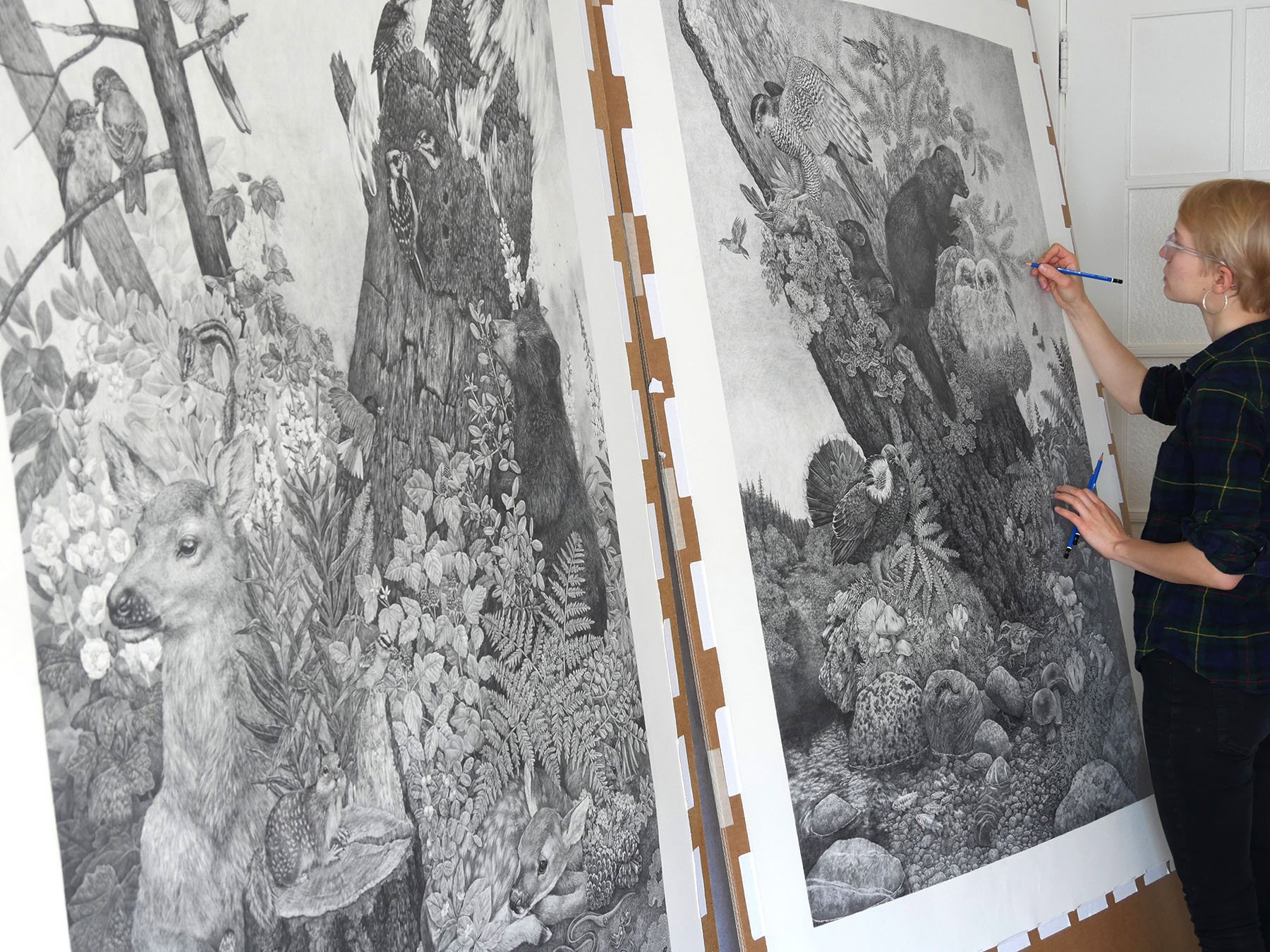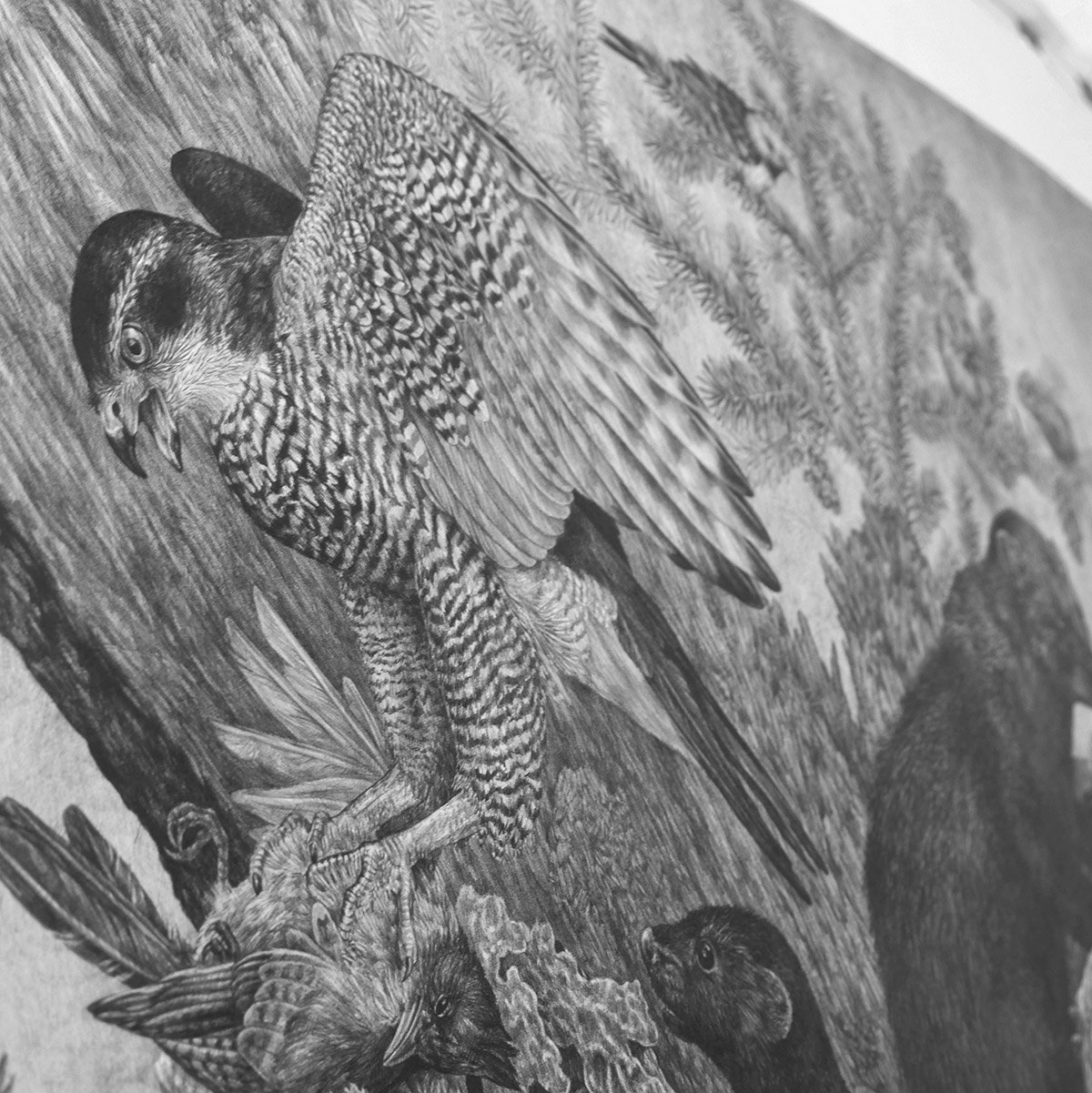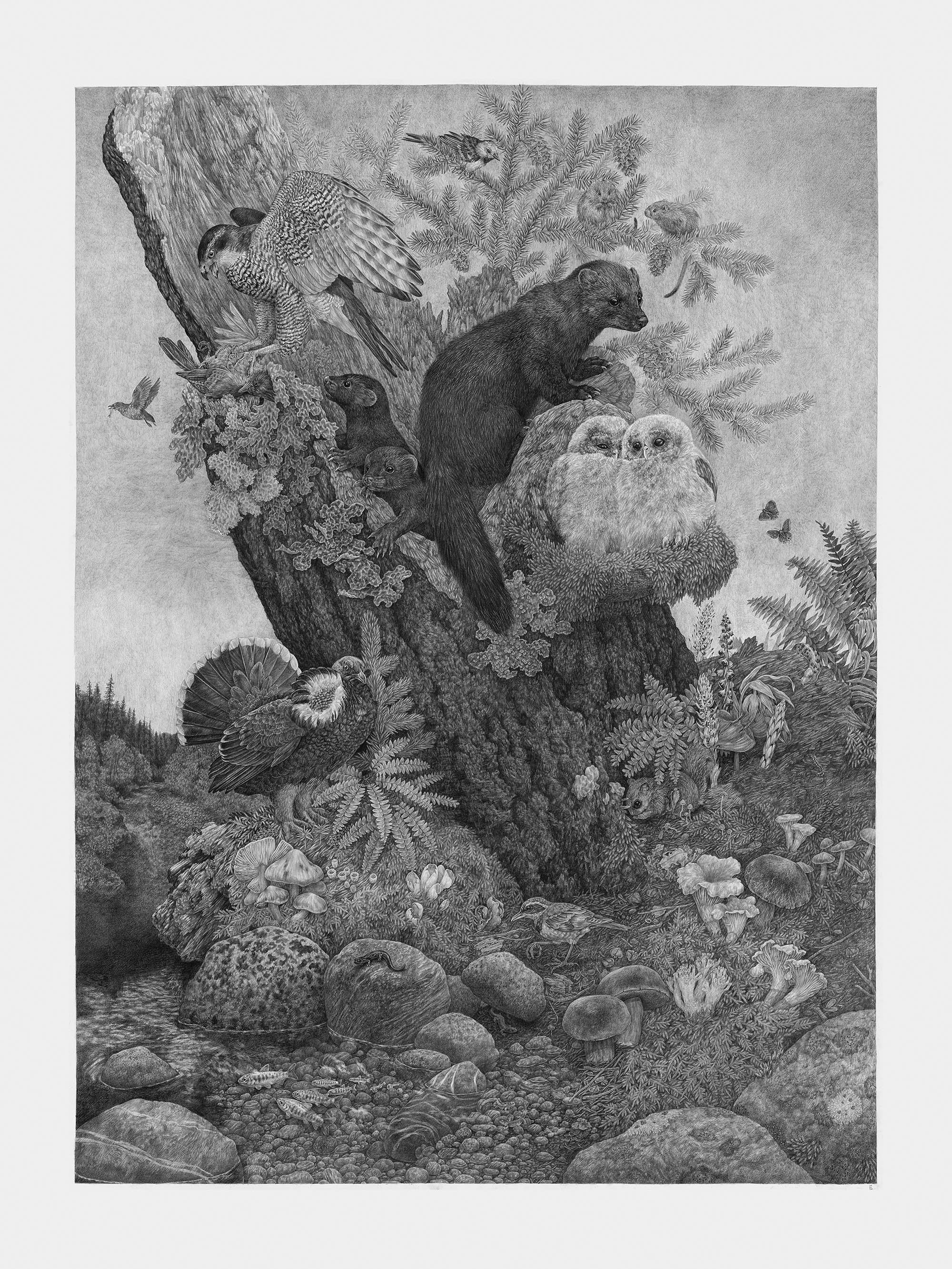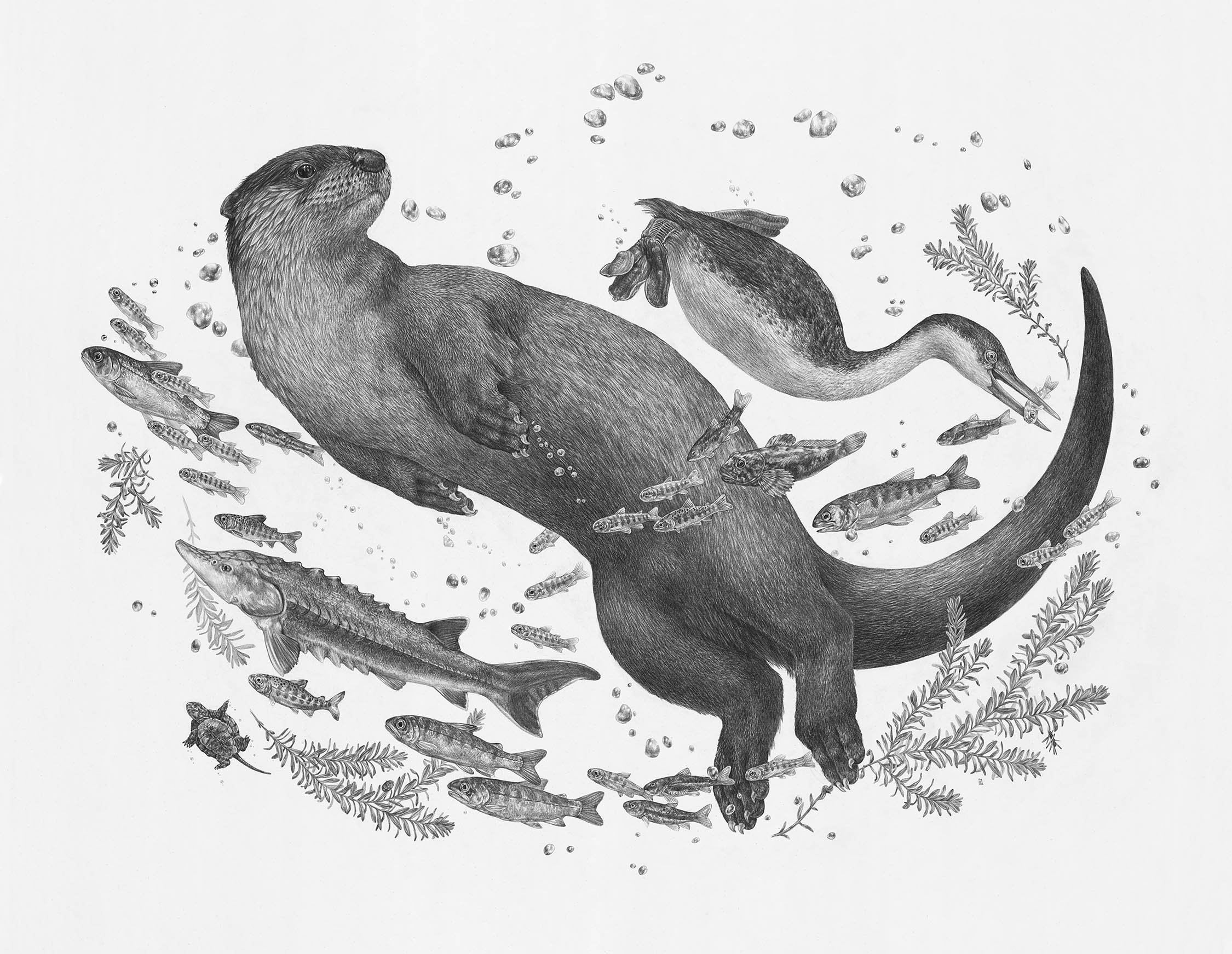KLAMATH-SISKIYOU
Forest Ditpych | Old Growth & Post Fire
The work for ‘Forest,’ my second solo show at Antler Gallery, was inspired by the flora and fauna of the Klamath-Siskiyou region of Oregon and California. The two pieces of the show’s central diptych, ‘Old Growth’ and ‘Postfire,’ focus on vital points in the life-cycle of Klamath Siskiyou forests: mature old-growth, and complex early seral, the stage of forest life that follows a disturbance like wildfire. By highlighting the fascinating and at-risk species that are dependent upon these stages of forest development, these two pieces underscore the importance of protecting forests at every stage of growth. Additional pieces in ‘Forest’ celebrate the region’s biodiversity and reflect upon my personal experiences in the region.
Notes and photographs that inspired ‘Forest’ were gathered during Signal Fire’s Wide Open Studios Klamath National Forest trip in the summer of 2017. Thank you to Jeanine Moy for providing valuable insight during the drafting of ‘Old Growth’ and ‘Postfire,’ and to John Villella for sharing knowledge about flora and lichens. Special thanks to Portland's Regional Arts and Culture Council for their generous Project Grant that made the framing of this show possible.
OLD GROWTH
Old Growth, 45" x 60" (114 x 152 cm), Graphite on paper, 2018
Old Growth Forests
‘Old Growth’ depicts thirty-four species found in the old growth forests of the Klamath-Siskiyou region of southwest Oregon and northwest California. The piece revolves around a Douglas Fir snag, a standing dead tree that provides vital habitat, covered in old growth specific mosses and lichens. A rare Pacific Fisher and its young den in the hollow tree. In the distance a federally threatened Marbled Murrelet flies towards its nest with food for its chicks. A Northern Goshawk sits poised over a captured Steller’s Jay, and two young Northern Spotted Owls huddle, not yet aware of their favorite prey species just below: a Northern Flying Squirrel, busily searching for the truffles that grow in symbiosis with Doug Fir roots. Poised above the fishers, a climate threatened Hermit Warbler forages in the forest canopy and two highly-specialized, arboreal Red Tree Voles feed on Doug Fir needles. A tangle of discarded needle resin ducts lies beside the Northern Flying Squirrel,
providing a tell-tale sign of thevoles’ presence in the forest canopy. A male Sooty Grouse flares its feathers in a mating display atop a nurse log bursting with ferns, mosses, fungi and beetles. The forest floor is rich with life: a Yellow Spotted Millipede, Pacific Golden Chanterelles, Western Sword Fern, Maidenhair Fern, Clustered Lady Slipper, and the parasitic Candy Stripe. A Varied Thrush is caught mid-scratch, searching for food among the litter. Along the water’s edge, boldly patterned rocks indicate the region’s rich geology, and three fragile creatures represent the Klamath-Siskiyou’s fascinating amphibians: from left to right, an endemic Siskiyou Mountain Salamander, an endemic Scott’s Bar Salamander and Southern Torrent Salamander. Among submerged pebbles, Coho salmon eggs hatch and grow from alevins to fry to parr, heading eventually towards the sea. In the distance, the Klamath River weaves its way among rocky shores and riparian forest edges.
POST FIRE
Post Fire, 45" x 60" (114 x 152 cm), Graphite on paper, 2018
What is a Complex Early Seral Forest
As a mixed or high severity fire sweeps across a forested landscape, it leaves behind the vital ingredients for the life of a new forest. Tree crowns burn, and some living trees are killed or damaged severely enough to die slowly in the following years. As these mature trees wane, the canopy is pulled open. Light rains down on the forest floor, nutrients and moisture once monopolized by trees becomes available for new forms of plant life, and the ground is made rich with woody debris. Grasses, wildflowers, shrubs, and hardwood and coniferous tree seedlings take hold in this landscape, weaving together complex and diverse plant communities. This burst of vegetation creates habitats for a diverse group of species. Grasses, flower nectar, seeds and berries touch off a tangled food web, twisting through insects to rodents, birds, and bats, and finally to raptors like Northern Goshawks and Northern Spotted Owls that hunt from adjacent unburned forests. Larger mammals - Roosevelt Elk, Columbian black-tailed deer, and black bears in the Klamath-Siskiyou region - browse on foliage and berries. Equally as important as this lush new burst of greenery are the blackened ghosts of fires past, elements of the forest that are called “biological legacies.” Standing dead trees called snags, downed trees and woody debris provide unique habitats. Birds perch on the branches of snags, flying out across the opened landscape to feast on the flush of moths, butterflies and other insects. Bats dart across the sky, sharing in the six legged buffet. Woodpeckers dig grubs out of blackened trees, and excavate nesting holes that are used by succeeding cohorts of birds and small mammals. This vibrant stage in the life of a forest is called a “complex early seral forest,” a name applied to forests recovering from any type of disturbance, including not only fire but also wind, severe flood or volcanic eruption. This stage lasts until tree seedlings grow tall and the canopy closes once again, a process that can take decades or even a century. Because of their high levels of biodiveristy and relative rarity across forested landscapes of the Pacific Northwest, complex early seral forests are considered just as precious as old growth forests.
Fire Regimes in the Klamath-Siskiyou Region
Fire has washed over the mountains of the Klamath Siskiyou for thousands of years, contributing to the region’s high level of biodiversity and shaping the region’s complex patchwork of forest types. Within a particular ecosystem the behavior of fire over an extended time scale can be described by a “fire regime,” a classification that points to the frequency, intensity and size of blazes in the ecosystem. In the Klamath-Siskiyou, fire-regimes are typically described as low to mixed-severity, occurring every five to every 35 years in drier vegetation and every 50 to 200 years in wetter and higher elevation areas. Low, or understory fire regimes, leave behind the majority of the dominant vegetation, doing little to change the structure of the ecosystem. Mixed-severity fire regimes are more complicated, but generally include a mixture of understory fires, crown fires that race along the upper branches of shrubs and trees and torching: when a single tree or small group of trees ignites and burns from bottom to top. Mixed-severity fires leave behind a puzzled landscape, with interlocking areas experiencing varying degrees of burning, sometimes over enormous areas. From July to November of 2002, the Biscuit Fire burned a mosaic across almost 500,000 acres (200,000 hectares) of mixed-evergreen forest. Biscuit was the largest blaze in Oregon’s history, and one of the largest in the modern history of the United States. The most dramatic fire regimes, called high severity or stand-replacing, torch the majority of dominant vegetation. Although their frequency is less understood, these fire regimes do occur in the Klamath Siskiyou region.
FOREST LIFE
Additional pieces for 'Forest' explore the biodiversity of the region.
River Otter, 36" x 28" (91 x 71 cm), Graphite on paper, 2018
Owl, 36" x 28" (91 x 71 cm), Graphite on paper, 2018
Wolf, 36" x 28" (91 x 71 cm), Graphite on paper, 2018
Callipepla Californica, 18" x 14" (46 x 36 cm), Graphite on paper, 2018
Crotalus Viridis Oreganus, 18" x 14" (46 x 36 cm), Graphite on paper, 2018











